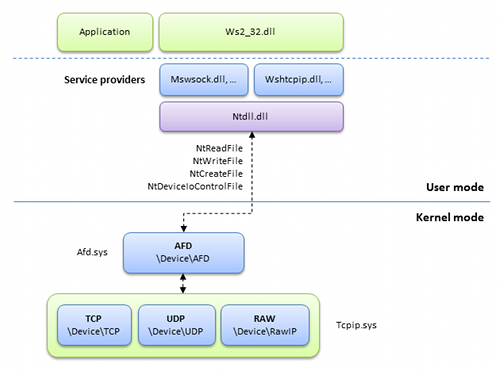

- Windows afd buffer defaultreceivewindow driver#
- Windows afd buffer defaultreceivewindow full#
- Windows afd buffer defaultreceivewindow windows#
Please remember to mark the replies as answers if they help, and unmark the answers if they provide no help. Just for completeness, adding instructions for increasing Windows OSs UDP receive/send buffer size in the UDP Multicast Setup might be easier for Windows. Microsoft does not guarantee the accuracy of this information. Please Note: Since the website is not hosted by Microsoft, the link may change without notice. Specifically, the application may be unable to. An operation on a socket could not be performed because the system lacked sufficient buffer space or because a queue was full. You run an application that creates loopback sockets on the computer. The default registry key value due to it may cause unknown problem in your machine.Īlthough you change the value, your upload performance is not determined by the TCP buffer, but the network condition and the hardware performance. You could read the link below to know more information. You have a multiprocessor computer that is running Windows Server 2008 R2 or Windows 7. When packets are read from the socket they are taken off the receive queue. Its what controls the system-wide default for socket buffers.
Windows afd buffer defaultreceivewindow driver#
On Windows 7 this is controlled by a network layer called AFD (Ancillary Function Driver for Winsock) and defaults to 8192 bytes. By pure coincidence I read this posting about windows network performance from 2009, referring to the AFD ('ancillary function driver') registry setting 'DefaultSendWindow' (along its partner, 'DefaultReceiveWindow').

In addition to that, we do not suggest you modify When UDP packets are received they are placed into a receive queue by the network layer. An exploitable buffer overflow in 'rcp' that can lead to access to kernel memory. However, we are not sure how Windows use this registry key to control the performance. On Windows 7 this is controlled by a network layer called AFD (Ancillary Function Driver for Winsock) and defaults to 8192 bytes. DefaultReceiveWindow & DefaultSendWindow are AFD values (AFD.sys is the Ancillary Function Driver, which basically acts as an entry point for Winsock functions to get to TCPIP.sys. From this To set the default size of the Windows use the following DWORD registry keys : HKEYLOCALMACHINE SYSTEM CurrentControlSetServicesAfdParameters DefaultReceiveWindow 10240 DefaultSendWindow 10240. thanks for looking into this.Based on my research, the registry key which you mentioned is about the size of the TCP send and receive buffer. The Windows system has a lot of improvements. Similar to Linux, Windows's Socket is ultimately mapped to a file, and all Socket files in Windows, such as creating, destroying, reading and writing, etc., all through AFD.
Windows afd buffer defaultreceivewindow full#
It seems to have something to do with the model/type or maybe because i am using more then one mixer ? Hopefully i have a new 2M/E on my test bench tommorow soo i will do some more tests thuis week. HKEYLOCALMACHINE SYSTEM CurrentControlSetServicesAfdParameters DefaultReceiveWindow 10240 DefaultSendWindow 10240 Share answered at 3:06 zangw 37. The full name of AFD is Ancillary Function Driver for Winsock, which is a core tool for the Windows System Network section. I am testing in the office on this moment with a ATEM television studio and this error does not show up.

Macro's made after startup of the client show up as normal. You can now not make new cue's with earlier made macro's.Īfter saving the mixer state and restoring the mixer all macro's from that mixer reappear. but things are still functioning (soo they are there but they don't show up). It's what controls the system-wide default for socket buffers. The macro's are gone in the dropdown menu on the right. By pure coincidence I read this posting about windows network performance from 2009, referring to the AFD ('ancillary function driver') registry setting 'DefaultSendWindow' (along its partner, 'DefaultReceiveWindow'). When starting up the client again with a earlier saved rundown. In Both setup's the mixers stay on 24/7 but the client is switched off every evening.

I am not sure how low-level you mean, but in case you were unaware, there is the Winsock function setsockopt. Side Note: there is a bug in the network statistics stuff for windows because even though the OS recieves a packet that it doesnt have application buffer. On Solaris, I solved this problem by increasing the UDP kernel receive buffer a gigabyte. HKEYLOCALMACHINESYSTEMCurrentControlSetServicesAfdParameters DefaultReceiveWindow 65536 DefaultSendWindow 65536. How can the Windows low-level UDP receive buffer be increased We are doing high speed datagrams, and some are getting dropped. On the Edit menu, Add Value name DefaultReceiveWindow, as a type REGDWORD. By Kerus Ashe in Windows (Last Updated On. I have 2 setup's where i am experiencing this. The Windows NT socket driver, Afd.sys has a 8KB default receive buffer.


 0 kommentar(er)
0 kommentar(er)
